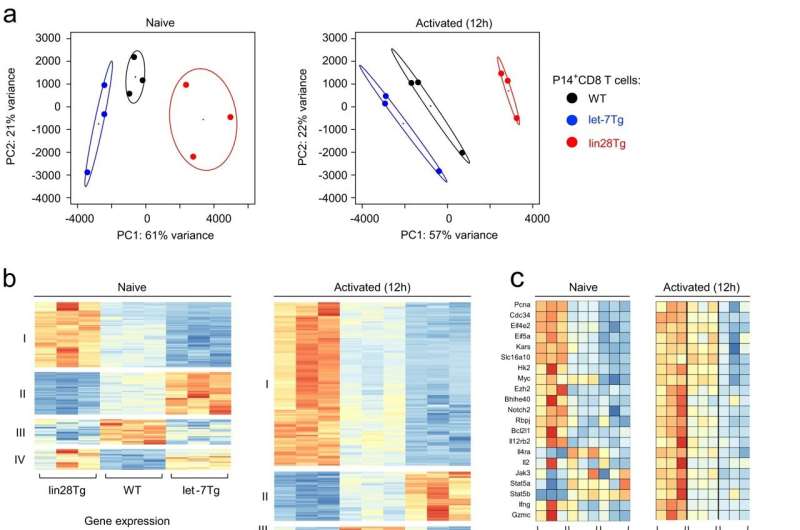This article has been reviewed according to Science X's editorial process and policies. Editors have highlighted the following attributes while ensuring the content's credibility:
fact-checked
peer-reviewed publication
trusted source
proofread
Researchers show how a small strand of RNA is key to fighting cancer

A team of researchers at the University of Massachusetts Amherst has shown that a single, small strand of microRNA, or miRNA, known as let-7, governs the ability of T-cells to recognize and remember tumor cells. This cellular memory is the basis for how vaccines work. Boosting cellular memory to recognize tumors could help improve cancer therapies.
The research, published recently in Nature Communications, suggests a new strategy for the next generation of cancer-fighting immunotherapies.
"Imagine that the human body is a fortress," says Leonid Pobezinsky, associate professor of veterinary and animal sciences at UMass Amherst and the paper's senior author, along with Elena Pobezinskaya, a research assistant professor also in veterinary and animal sciences at UMass. Our bodies have T-cells, which are white blood cells that specialize in fighting both pathogens, think of the common cold, and altered cells of the organism itself, like tumor cells.
Most of the time, the T-cells are "naïve"—mustered out of duty and resting. But when they recognize foreign antigens after bumping into them, they suddenly wake up, turn into killer T-cells and attack whatever the pathogen may be, from the sniffles to COVID, or even cancer. After the killer T-cells have won their battle, most of them die.
"But," says Pobezinsky, "somehow a few survive, transform into memory cells and form an elite task force called the 'memory pool'—they remember what that particular antigen looked like, so that they can be on the lookout for the next time it invades the body."
This is one of the mechanisms behind how vaccines work: infect the body with a weakened dose of a pathogen—say, the chicken pox virus—and the memory cells will remember what that virus looks like, turn into killer T-cells, annihilate the virally infected cells and then transform back into memory cells, waiting for the next time the chicken pox virus shows up.
But it's never been clearly understood just how T-cells form their memories.
Moreover, cancerous tumor cells work by tricking the killer T-cells, turning them off before they can attack and create a memory pool, leaving the cancer to metastasize unchecked.
"What we've discovered," says Pobezinsky, "is that a tiny piece of miRNA, let-7, which has been handed down the evolutionary tree since the dawn of animal life, is highly expressed in memory cells, and that the more let-7 a cell has, the less chance that it will be tricked by cancerous tumor cells, and the greater chance it has of turning into a memory cell." If the memory cell isn't tricked by the cancer, then it can fight and, crucially, remember what that cancerous cell looks like.
"Memory cells can live for a very long time," adds Pobezinskaya. "They possess stem-cell-like features and can live for 70 years."
"We are very excited, not only about the fundamental insights this research has provided, but also the translational impact it could have on next generation immunotherapies," says lead author Alexandria Wells, a postdoctoral fellow at the Cancer Research Institute who completed the work as part of her Ph.D. training at UMass Amherst. "In particular, understanding how let-7 is regulated during treatment to enhance the memories and capabilities of our own immune systems is a promising avenue for further research."
More information: Alexandria C. Wells et al, Let-7 enhances murine anti-tumor CD8 T cell responses by promoting memory and antagonizing terminal differentiation, Nature Communications (2023). DOI: 10.1038/s41467-023-40959-7


















